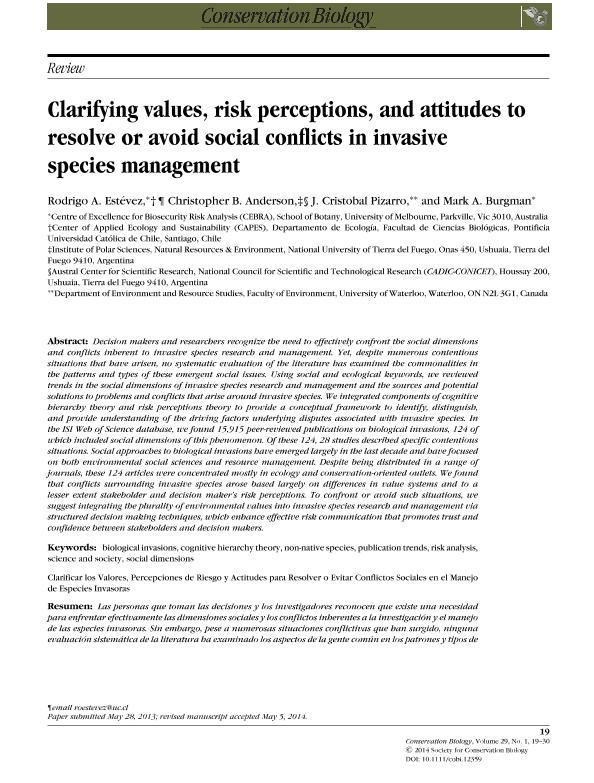Mostrar el registro sencillo del ítem
dc.contributor.author
Estevez, Rodrigo A.
dc.contributor.author
Anderson, Christopher Brian

dc.contributor.author
Pizarro, J. Cristobal
dc.contributor.author
Burgman, Mark A.
dc.date.available
2016-05-06T20:47:30Z
dc.date.issued
2015-02
dc.identifier.citation
Estevez, Rodrigo A.; Anderson, Christopher Brian; Pizarro, J. Cristobal; Burgman, Mark A.; Clarifying values, risk perceptions, and attitudes to resolve or avoid social conflicts in invasive species management; Wiley; Conservation Biology; 29; 1; 2-2015; 19-30
dc.identifier.issn
0888-8892
dc.identifier.uri
http://hdl.handle.net/11336/5565
dc.description.abstract
Decision makers and researchers recognize the need to effectively confront the social dimensions and conflicts inherent to invasive species research and management. Yet, despite numerous contentious situations that have arisen, no systematic evaluation of the literature has examined the commonalities in the patterns and types of these emergent social issues. Using social and ecological keywords, we reviewed trends in the social dimensions of invasive species research and management and the sources and potential solutions to problems and conflicts that arise around invasive species. We integrated components of cognitive hierarchy theory and risk perceptions theory to provide a conceptual framework to identify, distinguish, and provide understanding of the driving factors underlying disputes associated with invasive species. In the ISI Web of Science database, we found 15,915 peer-reviewed publications on biological invasions, 124 of which included social dimensions of this phenomenon. Of these 124, 28 studies described specific contentious situations. Social approaches to biological invasions have emerged largely in the last decade and have focused on both environmental social sciences and resource management. Despite being distributed in a range of journals, these 124 articles were concentrated mostly in ecology and conservation-oriented outlets. We found that conflicts surrounding invasive species arose based largely on differences in value systems and to a lesser extent stakeholder and decision maker?s risk perceptions. To confront or avoid such situations, we suggest integrating the plurality of environmental values into invasive species research and management via structured decision making techniques, which enhance effective risk communication that promotes trust and confidence between stakeholders and decision makers.
dc.format
application/pdf
dc.language.iso
eng
dc.publisher
Wiley

dc.rights
info:eu-repo/semantics/openAccess
dc.rights.uri
https://creativecommons.org/licenses/by-nc-sa/2.5/ar/
dc.subject
Biological Invasions
dc.subject
Cognitive Hierarchy Theory
dc.subject
Publication Trernds
dc.subject
Risk Theory
dc.subject.classification
Conservación de la Biodiversidad

dc.subject.classification
Ciencias Biológicas

dc.subject.classification
CIENCIAS NATURALES Y EXACTAS

dc.title
Clarifying values, risk perceptions, and attitudes to resolve or avoid social conflicts in invasive species management
dc.type
info:eu-repo/semantics/article
dc.type
info:ar-repo/semantics/artículo
dc.type
info:eu-repo/semantics/publishedVersion
dc.date.updated
2016-04-01T17:22:25Z
dc.journal.volume
29
dc.journal.number
1
dc.journal.pagination
19-30
dc.journal.pais
Reino Unido

dc.journal.ciudad
Londres
dc.description.fil
Fil: Estevez, Rodrigo A.. Universidad Católica de Chile; Chile. University of Melbourne. School of Botany. Centre of Excellence for Biosecurity Risk Analysis; Australia
dc.description.fil
Fil: Anderson, Christopher Brian. Consejo Nacional de Investigaciones Científicas y Técnicas. Centro Austral de Investigaciones Científicas; Argentina. Universidad Nacional de Tierra del Fuego; Argentina
dc.description.fil
Fil: Pizarro, J. Cristobal. University Of Waterloo; Canadá
dc.description.fil
Fil: Burgman, Mark A.. University of Melbourne. School of Botany. Centre of Excellence for Biosecurity Risk Analysis; Australia
dc.journal.title
Conservation Biology

dc.relation.alternativeid
info:eu-repo/semantics/altIdentifier/url/http://onlinelibrary.wiley.com/doi/10.1111/cobi.12359/abstract
dc.relation.alternativeid
info:eu-repo/semantics/altIdentifier/doi/10.1111/cobi.12359
dc.relation.alternativeid
info:eu-repo/semantics/altIdentifier/doi/http://dx.doi.org/10.1111/cobi.12359
Archivos asociados
